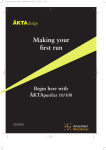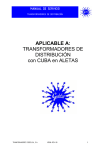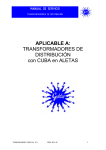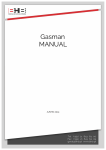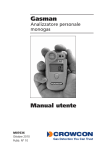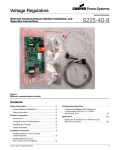Download Installation, use and maintenance Manual
Transcript
Tesar s.r.l. Installation and maintenance manual Installation, use and maintenance Manual Page :1\20 Tesar s.r.l. Installation and maintenance manual 1. INTRODUCTION 1.1. Reference Standards 1.2. Outline of the transformers and the accessories 2. RECEPTION, HANDLING, STORAGE 2.1. Reception 2.2. Transport and handling 2.3. Storage 3. INSTALLATION 3.1. Standard installation conditions 3.2. Windings over temperature 3.3. Dimensioning of air replacement 3.4. Insulating distances 3.5. Earthing connections and protections 3.6. HV and LV connections 3.7. Transformation ratio adjustment 3.8. Parallel connection of several transformers 4. TRANSFORMER PROTECTION 4.1. Temperature control system 4.2. Overloading and short circuit protection 4.3. Protection against overvoltages 5. COMMISSIONING 5.1. Mechanical checks before the commissioning 5.2. Electrical checks before the commissioning 5.3. Operations for the commissioning 6. MAINTENANCE, ASSISTANCE SERVICE 6.1. Ordinary maintenance 6.2. Extraordinary maintenance 6.3. Table for periodical checks 6.4. Problems solving Page :2\20 Tesar s.r.l. 1 Installation and maintenance manual INTRODUCTION 1.1. Reference Standards The cast resin transformer referred to the attached test report, has been designed and manufactured by TESAR in order to meet to Italian CEI and international IEC Standards requirements in force at the moment of its manufacturing (unless different agreement) as well as to meet the client specifications. • CEI Standards (Italian) - CEI 14-8 -Trasformatori di potenza a secco- Generalità CEI EN 60076-1 - Power transformer – part 1 : General CEI EN60076-2 - Power transformer – part 2 : Temperature Rise CEI EN 60076-3 - Power transformer – part 3 : Insulation levels, dielectric tests and external clearances in air CEI EN 60076-4 - Power transformer – part 4 : Guide to the lightning impulse and switching impulse testing - Power transformers and reactors CEI EN 60076-5 - Power transformer – part 4 : Ability to withstand short circuit CEI EN 60076-10 - Power transformer- part 10 determination of sound levels CEI 14-7 - Marcatura dei terminali dei trasformatori di potenza CEI 14-12 -Trasformatori trifasi di distribuzione di tipo a secco 50 Hz , da 150 a 2500 kVA con tensione massima per il componente non superiore a 36 kV -parte 1: Prescrizioni generali e prescrizioni per trasformatori con una tensione massima per il componente non superiore a 24 kV • IEC Standards (International) - IEC 60726 -Dry-type power transformers:General IEC 60076-1 - Power transformer – part 1 : General IEC 60076-2 - Power transformer – part 2 : Temperature Rise IEC 60076-3 - Power transformer – part 3 : Insulation levels, dielectric tests and external clearances in air IEC 60076-4 - Power transformer – part 4 : Guide to the lightning impulse and switching impulse testing - Power transformers and reactors IEC 60076-5 - Power transformer – part 4 : Ability to withstand short circuit IEC 60076-10 - Power transformer- part 10 determination of sound levels IEC 60616 -Terminal and tapping markings for power transformers HD 538.1 S1 - Three-phase dry type distribution transformers 50Hz, from 100 kVA to 2500 kVA with highest voltage for equipment not exceeding 36 kV-part 1 general requirements and requirements for transformers with highest voltage for equipment not exceeding 24 kV Page :3\20 Tesar s.r.l. Installation and maintenance manual Electromagnetic compatibility The intensity of low frequency magnetic field emitted by the windings is of a limited value and, however, it is equal or lower than those of the field emitted by the connections and the low voltage bars. Its value quickly decreases by increasing of the distance from the transformer. The intensity of the magnetic field can be significantly reduced by installing the transformer inside a metal enclosure (housing). The temperature control device or other auxiliary connections, included the thermoresistances, for the protection against electromagnetic disturbances conform to the Standard CEI EN 50081-2 (IEC 50081-2) and CEI EN 50082-2 (IEC 50082-2). Marking CE TESAR does not affix the marking CE on its transformers as foreseen at paragraph 5.4.2 of the “Guide to the application of the Directive 89/336/EEC” which excludes from the Directive application field: • High voltage inductor • High voltage transformer Page :4\20 Tesar s.r.l. Installation and maintenance manual 1.2. Outline of the transformers and the accessories Figure 1 Rating Plate sideways travel 10. Standard components and accessories 1. Tow attachment 2. Links for voltage variation 3. Pt100 thermo-resistances on the windings 4. Auxiliary connection box 5. Lifting eyes 6. LV terminals 7. HV terminals 8. Ground terminal 9. Truck with rollers for lengthways or Page :5\20 Tesar s.r.l. Installation and maintenance manual Optional components and accessories 1 Pt100 thermo-resistance on the core 2 Double Pt100 thermo-resistance on the windings 3 Thermistors on the windings/Core 4 Tangential fans for power increase 5 Metallic screen between primary and secondary connected to the ground 6 Rubber wheels 7 Thermo-controller 8 Multifunctional device for temperature and electric parameters check 9 Enclosure 10 Bushings for HV terminals 11 Cover for tap-changers Figure 3 Thermocontroller Figure 4 Double Pt100 on the core Figure 5 Bushing for HV terminals Figure 6 Cover for tap-changer Figure 8 Tangential fans Figure 7 Enclosure Page :6\20 Tesar s.r.l. 2. Installation and maintenance manual RECEPTION, HANDLING, STORAGE 2.1. Reception The transformer is generally supplied totally assembled and ready to be connected to the medium and low voltage line. According to the specification, the transformer is shipped with a polythene protection, or packed into wooden cage, for protection against dust and little shocks, or finally packed into a wooden case for over-sea shipments. On receipt of the transformer, both at the client's plants or site, it is necessary to carry out the following checks: • To check there are not signs of damage on the packing or the transformer occurred probably during the transport. • The characteristics of the transformer detailed on the rating plate must correspond to those of the shipping documents and with those of the test report, which is attached to the transformer. • To check that each transformer is complete with the accessories foreseen in the contract (wheels, thermo-controller etc.). Before unpacking the transformer, especially during winter period when the temperature difference between the room and the outdoor is considerable, it is necessary to wait for a period of at least 8-24 hours in such a way that the temperature of the transformer has the necessary time for reaching that of the room, in order to avoid water condensation on the coils surface. IMPORTANT: In case any anomalies are found, please contact immediately the manufacturer. If within 5 days there will be no notification of anomalies or defects, it can be considered that the transformer has been delivered in perfect conditions. The manufacturer, therefore, cannot be considered responsible neither for what could happen to the transformer during service nor for the eventual consequences. 2.2. Handling During the transport or the handling, it is recommended to use only the special lifting eyes and tow attachments. IMPORTANT: The transformer cannot be moved pushing the coils and the connections. For locating the transformer in the final position, act only by means of a suitable lever on the special points foreseen on the lower frames and not on the magnetic core and/or on the windings. For lifting, the upper frame of the transformer is complete with nos. 4 lifting eyes for slings. Lift with a maximum sling angle of 60°. If the transformer is complete with protection enclosure, take off the roof to attach the slings. Page :7\20 Tesar s.r.l. Installation and maintenance manual Handling examples Figure 9 Handling by means of an overhead-travelling crane Figure 11 Manual handling Figure 10 Handling by means of a forklift Figure 12 Wrong manual handling 2.3. Storage The transformer must be stored in a sheltered, clean and dry ambient maintaining the packing up to the installation. IMPORTANT: The storage temperature must not be lower than -25°C. Page :8\20 Tesar s.r.l. Installation and maintenance manual INSTALLATION 3.1. Standard installation conditions The maximum height of installation must not exceed 1000 m above sea level. When the transformer is in service, the ambient temperature of the room must be within the following limits: • Minimum temperature: -25°C • Maximum temperature: + 40°C In case the height of the place of installation and/or the ambient temperature values are higher that the ones specified above, it is necessary to specify it at the ordering stage since a particular dimensioning of the transformer depends upon these values. 3.2. Windings over temperatures The electric current passing through the windings, and the effect of the core magnetising current produce electrical loss resulting in localised heating of the core and windings. The transformer is designed in such a way that natural cooling maintains the transformer temperature under the maximum values foreseen by the standards. In order to avoid temperature accumulation in the room where the transformer is installed, it is necessary to provided suitable ventilation. The standard (with max ambient 40°C) winding temperature of the transformers designed to work in standard conditions, as foreseen at par. 3.1., change as a function of the insulation class and they must not exceed the limits specified on the following table: Insulation class Medium windings temperatures °C Maximum temperature of the insulating system °C B 120 130 F 140 155 Each TESAR transformer, is complete with at least nos. 3 PT100 thermo-resistance probes, one for each low voltage winding and wired to a junction box for connection to the thermo-controller usually supplied loose. For connecting and setting the thermo-controller against over temperature, please read the relative manual attached to the same. For the regulation we suggest the values showed on the following table: Insulation class Alarm °C Trip °C B 100°C 120 °C F 120°C 140°C Page :9\20 Tesar s.r.l. Installation and maintenance manual 3.3. Dimensioning of air louvers • Natural cooling In the room where the transformer is installed, it is necessary to install air louvers sufficient to dissipate the heat during service, in order to guarantee the standard service conditions and to prevent the transformer from exceeding the over temperature limits. Therefore the room must be provided with a louver on the lower part S, in order to guarantee an appropriate fresh air flow; and a louver S’ on the upper part of the opposite wall, in order to extract the hot air due to the "chimney effect" (figure 13). For a correct dimensioning of the louvers on the room, use the following formula, to calculate the surface of the louvers for air incoming and outgoing, for a nominal annual ambient temperature of 20°C. P S ≡ 0.188 ⋅ S ' ≡ 1.10 ⋅ S where: H P S S’ H = = = = Sum of the transformer no-load losses and the load losses at 120°C in kW. Surface of the incoming louver in m2 Surface of the outgoing louver in m2 Height between the two louvers in meters Figure 13 Natural cooling • Forced cooling Forced cooling is necessary in the following cases: • Frequent overloading • Low-dimensioned room • Room scarcely ventilated • Medium daily temperature higher than 30°C. Page :10\20 Tesar s.r.l. Installation and maintenance manual The forced cooling can be realized by means of: • • Tangential fans or other technology, installed directly during the manufacturing stage or added successively at site, dimensioned as a function of the transformer power and of the over temperature to be dissipated. Installation of air extractor located in the upper part of the room (or the enclosure) controlled by a suitable thermostat or directly by a transformer thermal protection relay, with a suggested flow of approx. 3,5÷4 m3/min. for each kW of losses at 120 °C. ATTENTION: an insufficient air circulation, besides reducing the nominal life of the transformer, causes over heating which, in the worst cases, can determine the intervention of the thermal protection relay. 3.4. Insulating distances The transformer supplied for service without enclosure (IP00) must be installed in the relative room respecting the insulating distances specified here under. The transformer must be protected against direct contacts; it must be remembered that the resin be considered as a part under voltage. Furthermore it is necessary: • To eliminate the risk of water dripping on the transformer. • To respect the minimum distances towards the walls and towards ground as a function of the insulating voltage according to the following table. Figure 14 Insulating distances Page :11\20 Tesar s.r.l. Installation and maintenance manual Insulation Distance “D” mm KV Concrete Wall Grilled 7,2 150 300 12 150 300 17,5 220 300 24 240 300 36 320 320 3.5. Earthing connections, taps and protection position Tesar is not responsible for the transformer installation. The installation must be carried out according to the standards in force, to the applicable laws and to the present instructions. The following points must be taken into consideration when the installation is carried out: • To connect the earthing conductors to the relative earth points on the metallic parts of the transformer and enclosure. • To connect the low voltage neutral to earth when required or when required by the protection system to earth. • To connect the thermal protection to the control system according to the sketch as shown in the thermal protection relay manual (thermo-controller). • To ensure that the connection means of the primary winding are safely bolted. • To ensure that the voltage regulation taps are safely bolted, and if necessary modify the position as a function of the supply voltage. Note : At the time of shipping, the links of the voltage tap-changer are located on the central tap. • In case of transformers with double ratio, please be sure that the link corresponding to the voltage of the system feeding the transformer is properly connected. Note: At the time of shipping, the links of the voltage tap-changer are connected on the position corresponding to the nominal voltage. 3.6. LV and HV connections • Execution without enclosure (IP00) The cables and the bus bars which are connected to the transformer must be duly fixed to avoid any mechanical stress on the LV and HV transformer terminals. Both upper and bottom cable connections can be performed, being sure, however, to respect the configuration showed in the drawings. In case the connections arrive from the bottom please ensure that there is sufficient depth for the minimum radius of curvature of the cables. Page :12\20 Tesar s.r.l. • Installation and maintenance manual Execution with protection enclosure The cables and the bus bars which are connected to the transformer must enter the enclosure only through suitable flanges specified at the ordering stage. In any case the cables and/or the bus bars must be duly fixed outside the enclosure to avoid any mechanical stress on the LV and HV terminals of the transformer. After the installation please check the correct degree of protection is maintained near the passageway of the cables and the bus bars. Figure 15 Cables coming from the top Figure 17 Conductor fixing Figure 16 Cables coming from the bottom Figure 18 Cables fixing on the enclosure Page :13\20 Tesar s.r.l. Installation and maintenance manual 3.7. Regulation of transformation ratio The variation of the primary voltage is obtained by changing the position of the link located on each HV coil. Generally, the transformer is delivered with the link of each column located in the central tap. In case the primary voltage of the system does not correspond exactly to the voltage of the central tap, it is necessary to modify the position of the tap duly positioning it on one of the other taps in order that the secondary obtained is the no-load voltage shown on the rating plate. Figura 19 Tap-changer Important A) In case of transformers with double ratio, please be sure the tap corresponding to voltage of the system feeding the transformer it-self, is duly connected. B) In case the position of the link has to be changed after the transformer has been put into service the first time, it is recommended to put the transformer out of service and to connect to ground the LV and HV circuits before approaching the transformer. 3.8. Connection in parallel of more transformers If the transformer must be connected in parallel with other transformers, please verify the total compatibility of the voltage ratio and of the conditions stated by the IEC 60076-1 standards, and particularly: • Identical voltage ratio • Identical frequency of functioning • Identical vector group • Identical short circuit voltage (Tolerance ± 10%) 4. TRANSFORMER PROTECTIONS 4.1. Over temperature protection by thermo-controller Each TESAR transformer is completed with at least nos. 3 thermo-resistances Pt 100, located inside each LV winding and connected to a connection auxiliary box and with the thermo-controller usually supplied loose. Page :14\20 Tesar s.r.l. Installation and maintenance manual For the connection and the setting of the protection relay, please read the relative manual attached to the same. Figure 20 Thermocontroller and fans control relay 4.2. Overloading and short circuit protection According to the parameters of the standards shown at point 1.1., the transformer is designed and manufactured in such a way to withstand limited abnormal situation of over-voltages, overloading and short circuit on the secondary windings. Therefore, the transformer must be protected against thermal and dynamic effects caused by continuous overloading and secondary short circuits by means of an automatic switch or suitable fuses, able to disconnect the transformer in case of current flow higher than the one fixed to the protection. The protections setting and/or the choice of fuses HV and LV side, must be carried out taking into consideration the primary and secondary rated currents stated in the transformer rating plate, taking also into consideration that when we feed the transformer, a very high magnetizing current is established on the primary, by means of variable starting from a minimum of 10 times the rated current (in the worst conditions of insertion depending from the instant when the feeding circuit is closed, from the electric characteristics of the feeding network, from the reactance and resistance values of the circuit network-transformer, the insertion current can reach also 20 times the rated current), even if the automatic switch located on the secondary is open and therefore without loading. Therefore, it is necessary to duly set the relay of maximum current HV side, in current and time value, by introducing a little delay (approx. some tens of ms), in such a way that the protection relay will not operate. Furthermore, we suggest limiting the number of connections and disconnection of the transformer on the network. 4.3. Protection against over voltages In order to protect the transformers against over-voltages at industrial frequencies or the ones due to atmospheric origin, it is recommended that voltage surge arrester with variable resistance are used. The characteristics of the surge arresters depend on the transformer insulation level and from the characteristics of the distribution system. It is recommended to install the surge arresters when the transformer is connected, directly or through a short cable, to the main networks. Page :15\20 Tesar s.r.l. 5. Installation and maintenance manual COMMISSIONING 5.1. Mechanical checks before the commissioning Please affect the following checks: • Check the earth connections • Check of the insulating distance of the parts under voltage towards ground as shown at paragraph 3.4 • Check the tightening of HV and LV terminals and of the links of the tap-changer applying the following values of the tightening torque. Connection of HV terminals and of the links of the voltage taps Bolts M6 8 10 12 14 16 Torque N/m 5 11 22 35 60 85 Connection of LV terminals Bolts M6 8 10 Torque N/m 5 14 27 12 45 14 70 16 100 Mechanical parts Core and Frame Bolts M12 14 16 18 20 22 Torque N/m 95 150 235 320 455 615 With torque wrench set in kgm, divide the values by 10 5.2. Electrical checks before the commissioning Please affect the following checks: • Verify that the position of the links of tap-changer is equal on all the three phases as shown in the connection diagram. In case of double primary voltages, please check the feed to the transformer correspond to the links position. • Check the correct functioning of the switches located as protection of the transformer on HV and LV side. • Check the correct setting and functioning of the overloading and short-circuit protection relay. • Check the correct setting and functioning of the over-temperature protection relay (thermo-controller) and of the relative probes. • Check the functioning of the fans and of the relative control circuit, if they are installed on the transformer or on the enclosure • Check the general conditions of the transformer and proceed with the measurement of the insulating resistance by means of a Megger functioning at 2500 V. This measurement must be carried out with HV and LV terminals disconnected from the equipment, it means before connecting the cables and/or the bus bars. The values of the measured resistances must be approx. the following: • HV terminals / LV terminals grounded ≥ 20 MΩ • LV terminals / HV terminals grounded ≥ 10 MΩ • HV terminals - LV terminals / ground terminal ≥ 10 MΩ In case the values results to be considerably lower, the transformer must be dried and, if necessary, please contact our assistance service. Page :16\20 Tesar s.r.l. Installation and maintenance manual ATTENTION: In case a transformer is put into service after a long storage period, or after a long de-energised period, it will be necessary to clean the HV/LV windings from eventual dust, condensate and dirt, by means of dry compressed air jets and dry cloth. It is recommended, finally, to carry out always a visual check of the transformer in order to verify any unlikely presence on the surface and inside the cooling ducts. 5.3. Operations for commissioning Closing of HV switch When the switch is closed the transformer gives out a sharp noise, which decreases in few ms until it stabilises. Check of secondary voltages Before closing the low voltage switch or effecting additional checks for the parallel service with other transformers, it is necessary: • Check by means of a voltmeter the proper value between each two phases and of the three wye-connected voltage. • Check the proper displacement of the phases and the correct vector group. In case the values correspond to those stated in the rating plate, it is possible to proceed and complete the commissioning or to carry out the checks for the parallel service. Run in parallel service with other transformer In case the transformer has to run in parallel with another, it is also necessary: • Check the compatibility of the rating plates of both transformers • Verify the concordance of the phases by measuring the voltage between the phase "one" of the transformer already in service and the phase "one" of the transformer to be connected in parallel by means of a voltmeter. The value of this result must be zero. Continue in the same way for phase 2 and phase 3 Complete the commissioning of the transformer closing the LV switch and feeling the Switchgear. IMPORTANT We remind you that qualified technical personnel must carry out the operation, commissioning and energization. Furthermore, during the voltage measurements and the phase displacement checks on the upper terminals of the LV switches, you are recommended to use suitable instruments and suitable insulating gauntlets. 6. MAINTENANCE, ASSISTANCE SERVICE 6.1 Ordinary maintenance A careful check of the transformer during its functioning will prevent damage and prolong its life. In standard service conditions it is sufficient to perform, at least once per year, the following operations: Page :17\20 Tesar s.r.l. Installation and maintenance manual • Cleaning of the HV/LV windings from eventual dust, condensate and dirt, by means of dry compressed air jets and dry cloths • Cleaning of the cooling and ventilation ducts between the coils in order to avoid overheating during service • Verify of tightening of the HV and LV connections, of the voltage tap-changer links and of the bolts (yoke and spacer blocks) • Check the correct functioning of the thermal protection (thermo-resistances and thermo-controller) as well as of the correct intervention of the overloading and shortcircuit protection and tripping of the corresponding automatic switch. This check must be carried out preferably by means of suitable equipment that will allow the simulation of the real damage. In case it is found absences, which cannot be eliminated, please contact immediately our Assistance Service Phone (+39)-0575.317 1 Fax (+39)-0575.317 201 E-Mail [email protected] 6.2 Extraordinary maintenance In case the transformer function in a discontinuous way, before the commissioning, especially after a long stop, it is necessary to perform the entire checks prior the commissioning listed on chapter 5. In case the transformer during its operation has withstood exceptional events such as: short circuits, atmospheric or operational over-voltages, overflowing, or other exceptional events, before energizing it once again, you are requested to call for our service. In this case it can be undertaken an agreement for the extension and/or the renewing of the guarantee period. Page :18\20 Tesar s.r.l. 6.3 Installation and maintenance manual Table for periodic checks The main periodic checks to be performed on the transformer, the check intervals, the equipment to be used and the results to be obtained are reported on the following table. Pos. 1 2 3 4 Check to be performed Check Interval Cleaning from dust, dirt, unlikely presence on the windings Tightening of the bolts of the main and secondary electrical connections Tightening of the mechanical parts bolts and transformer clamping to the ground Yearly and/or after Tightening of plate for exceptional events adjusting the spacer blocks 5 Functioning check of thermocontroller and thermoresistances 6 Functioning check of the overloading and short-circuit relay 7 Condensate deposited on the windings 8 Insulation check of the windings among them and towards ground Instrument /Equipment Results Dry compressed air General cleaning and cloths Torque wrench Tightening torque see paragraph 5.1. Torque wrench Tightening torque see paragraph 5.1. Tightening torque see paragraph 5.1. Intervention of the Hot air gun for siren of alarm level, thermo-resistance opening of switch and simulated heating trip level Opening of the switch Power generator for on reaching the pre-set simulation of damage threshold. Coil surface and Hot dry air and cloths internal ducts After a long perfectly dry transformer stop Minimum values Megger with voltage showed at paragraph of at least 2500 V 5.2 Torque wrench For more accurate and complete checks, please contact our Assistance Service Phone (+39)-0575.317 1 Fax (+39)-0575.317 201 E-Mail [email protected] Page :19\20 Tesar s.r.l. 6.4 Installation and maintenance manual Resolution of the problems The interventions to be performed as a consequence of problems which may occur during service, are scheduled here under: Pos. Trouble monitored Possible cause To carry out Excessive load respect to the rated power of the transformer Check by means of a suitable equipment, the current delivered by the transformer and compare it with the one stated in the rating plate. Reduce the load bringing the power under the transformer rating. Check by means of a suitable instrument, the current delivered by each transformer phase and eventually reequilibrate the single-phase loads on the three phases Limit the numbers of consecutive start-up of the nonsynchronous motors with starting in s.c. Insert chokes or filters before the equipment that generates harmonics in order to prevent their migration on the network and on the transformer. Check the ventilation louvers of the substations or of the protection enclosure are not occluded. Restore the air circulation Restore the insulation of the tie rods and tighten the bolts of the core with the corresponding tightening torque as foreseen at paragraph 5.1 Move the links of the tapchanger on the most suitable ratio 1 Irregular load distribution on the three phases 2 3 Intervention of the thermocontroller due to alarm on the windings (thermo-resistances Start up of non-synchronous PT100 on each winding) motors in s.c. with high starting currents 4 Presence of harmonics on the distribution system. 5 Lack of ventilation on the room where the transformer is installed 6 Intervention of the thermocontroller due to alarm in the core (4th thermo-resistance PT100 on the core, if foreseen) Excessive background noise 7 High eddy currents on the core due to possible breaks of the tie rods insulation and loosening of the tightening bolts of the core To high supply voltage For more accurate and complete checks, please contact our Assistance Service Phone (+39)-0575.317 1 Fax (+39)-0575.317 201 E-Mail [email protected] Page :20\20
























